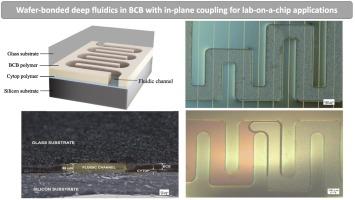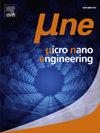Wafer-bonded deep fluidics in BCB with in-plane coupling for lab-on-a-chip applications
Abstract
The wafer-scale fabrication of deep channel microfluidics for lab-on-a-chip applications by reactive ion etching and wafer bonding is reported. The microfluidic channels are etched in B-stage bisbenzocyclobutene (BCB) and Cytop with the latter used as a bonding agent. The channels are hermetically sealed between Borofloat glass and Si wafers by wafer bonding. Fluidic coupling is achieved in the plane of the channels via inlets and outlets that are revealed on the end facets of chips after dicing. Process techniques and details are reported for uniform coating and curing of BCB and Cytop, defining the channels with high accuracy using photolithography, dry etching the polymers using a hard mask, and sealing the channels by wafer bonding. Fluidic measurements are carried out at various flow rates and compared with modeling. The low Reynold's numbers of the channels ensure laminar flow conditions. Deep fluidic channels are less difficult to align to fluidic interfaces, they support higher flow rates and are less susceptible to clogging. In-plane fluidic coupling precludes the need to etch holes through the substrate. Our wafer-scale process was applied to 4 in. diameter wafers yielding 195 precision-aligned and hermetically sealed microfluidic chips, but is readily scalable to larger diameter wafers for volume production.


 求助内容:
求助内容: 应助结果提醒方式:
应助结果提醒方式:


